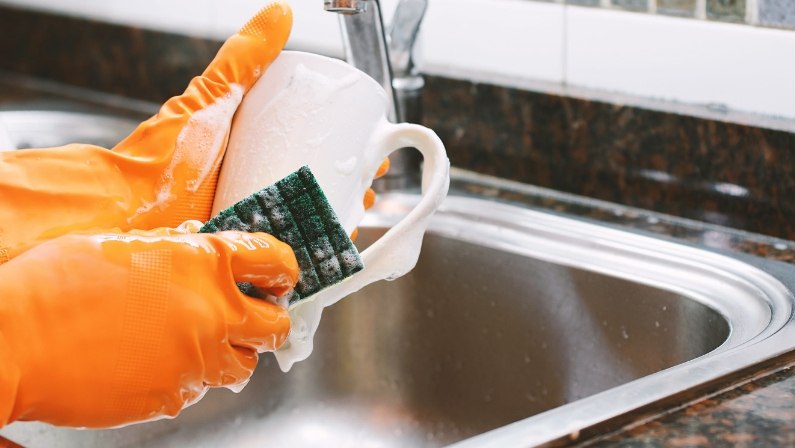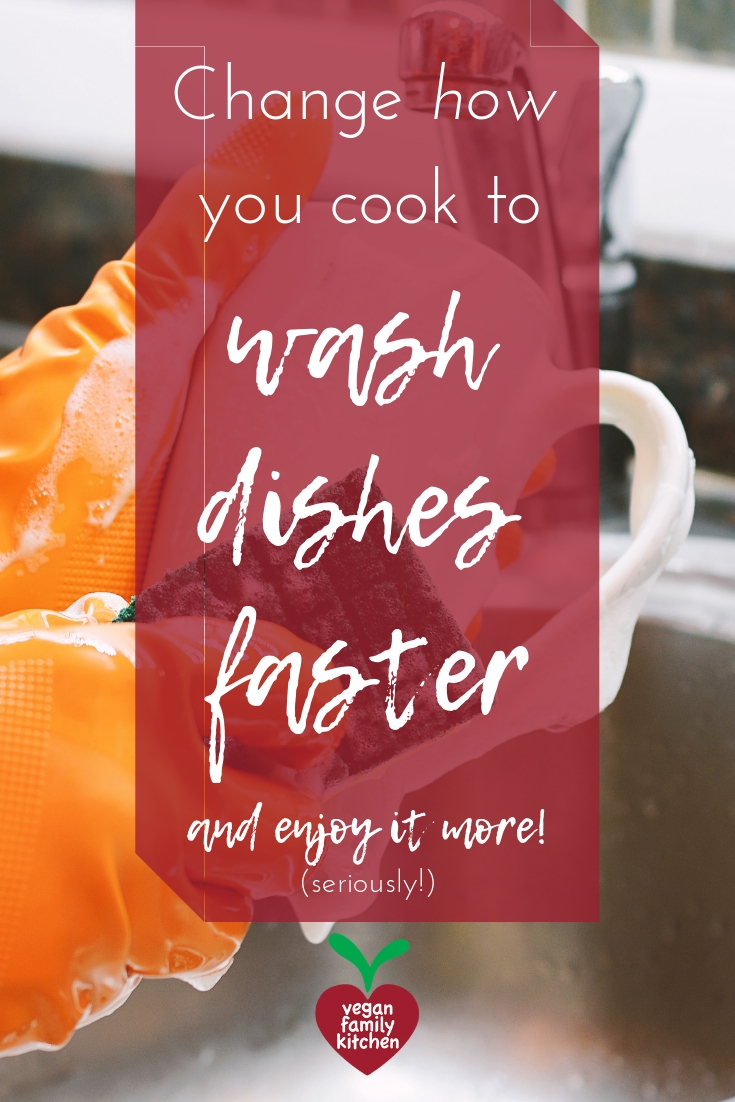Has your life gone to the dishes? Try changing how you cook to make cleanup go faster.
Eating three home-cooked meals per day consisting of plant-based whole foods will do wonders for your health. It will probably also improve your family’s life as you say “yes!” to really good meals. But… oh my! the dishes!
The good news is that vegan cooking usually is less sticky, because we use no awful, smelly animal fats. Nevertheless, I won’t lie: more home-made meals mean more dishes to wash. It’s just a part of life. Enrolling help is great, but you can also do a lot as you cook to make the process less tedious in the end.
Embrace the one-pot dinner
Aside from the fact that I find them uninspiring, 3-part dinners (protein – veggie – starch) require too many dishes! Most of my family’s meals have everything we need conveniently cooked in a single pot. At most, we’ll be using two (one for the entree and one for the grains or noodles). Batch cooking whole grains and beans on the weekend means fewer dishes to do on a day-to-day basis.
Make it clean before you make it dirty
Before you start cooking your next meal, clean and clear whatever dishes may have accumulated during the day. Messy disasters are more likely to happen if you’re working in a cramped space. Moreover, you don’t want to find the mixing bowl you need covered in batter from the morning’s pancakes.
(Try to) Keep it clean as you go thanks to your dishwashing station
Keep one half of your sink half-full of hot soapy water and try to clean a few things as you go. Place the clean items in a rack next to the sink to dry. (No double sink? Use a big bowl to soak the stickiest bits.) Protect the “clean dishes” area against the incursion of dirty dishes. The utensils you can clean while the sauce is simmering are utensils you won’t have to clean after dinner.
Remember that not everything needs to be thoroughly washed between every use
You can measure multiple spices with the same measuring spoon. Unless it’s mission-critical (e.g., when measuring baking powder), half a teaspoon can be eyeballed in a teaspoon. No need to get both dirty! With a little advance planning, you can use the blender twice for one meal with just a quick rinse in between uses. You can use the same spatula to stir the sauce and the pasta.
Forget about mise en place (exceptions apply)
Mise en place is what professional chefs do in restaurant kitchens. They get their line cooks to chop and prep everything in advance. Every ingredient gets measured and placed in a matching container, ready to add to the dish. It works great for restaurants… but at home, 95% of the time, it only means cooking your meal will take longer… and use way too many bowls!
Most home-made, weeknight dinners will look something like this:
- preheat the pot/skillet,
- while it preheats chop your first veggie or two,
- then prep each ingredient as you supervise what’s already cooking.
Some ingredients may end up cooking 30 seconds more than you’d like… but weeknight dinner dishes should be forgiving enough to allow that. A notable exception to this rule is sauce or spice mixes, which you may want to prepare before you turn the heat on. Sometimes, things start to happen quickly! This is especially true if you are cooking with a stir-fry.
Another exception is if you have an infant or toddler (or both!), in which case you may want to start chopping your dinner’s ingredients at around 1 pm… A better path might be to get some help on the weekend and prep it all in a big batch cooking session. (Rest assured: things will improve once your kiddos get a little older.)
Consolidate your cooking in a weekend prep session
Think of it as a mega-mise en place. You can prepare your upcoming meal’s building blocks ahead of time so do you don’t have to fuss over it on weeknights. You will save lots of time on dishwashing because you only need to use one big pot to cook rice for three or four different meals. (Make sure your storage containers are dishwasher safe to save even more time.)
Always deglaze pots and pans
This simple trick will save you HOURS over the course of a year.
Whether you are making soup, stew or stir-fry, start by cooking the onion and vegetables. After a few minutes, add the spices, then deglaze the pot by throwing in 1/4 to 1/2 cup of cold liquid. Scrape the bottom of the pot right away with a flat-end spatula to detach the caramelized bits. Those sweet morsels belong in your tummy, not the garburator! As the liquid rapidly steams off, it will help “clean” the bottom of your pot. You can use water, but there are better options: vegetable broth, citrus juice (lime, lemon, orange…), tomato juice, aromatic vinegar, wine or beer will add more flavor to your dish. (If using an alcoholic liquid, know that the alcohol will evaporate in a few minutes of cooking.) Make sure to match the liquid to your dish’s flavor profile. (Don’t try this with a plant milk.)
Don’t crowd the dishwasher
If water can’t reach it, it can’t clean it. We only use the dishwasher for plates and bowls, silverware, and glasses and cups. They all fit nicely in the dishwasher’s racks. Pots and pans? Not so well. Plus, with the high water pressure in the appliance, they can hit my other dishes and chip them. Booh! Remember that cast iron cookware, knives, and wooden cutting boards do not go in the dishwasher anyway.
Use a sinkful of water – no need to keep it running the whole time!
Pile your dirty dishes on one side of the sink (not IN the sink!), and make sure your drying rack and mat/towel are laid out on the other side. Put on dishwashing gloves, plug the sink, add a few squirts of soap, and start running the hot water. Scrape any leftovers into the compost bucket or garbage disposal. Use your favorite scrubber, start washing the dishes and rinsing as you go. Begin with the less-dirty pieces and keep the yuckiest ones for the end. The water pooling at the bottom of the sink will be clean enough to help you soak and scrub off the tougher bits. The gloves will protect your hands against the super-hot water so you can be quicker and more efficient.
Wash dishes like a scientist
If you have a dishwasher, do you rinse dishes so well before you put them in… that you might as well have put the dishes straight into your cabinets instead of into the dishwasher? My mother does that. She says her dishwasher doesn’t clean dishes very well. I’d rather “touch once”: rinse the dishes, put them in a drying rack and put them away, rather than detour through the dishwasher.
If you have that habit, why not run an experiment this weekend:
- Scrape leftovers off the plates, but do not rinse.
- Take photos of your dishes as they go in.
- Run the dishwasher per normal.
- Look at the results, using the photos for reference.
How did it go?
Now you know how well your dishwasher cleans dishes. If the answer is “not well at all,” then maybe consider adopting the “touch once” approach above. I bet it will not take you any longer to do dishes that way compared to loading and unloading the dishwasher.
Get satisfaction
In our modern life, there are few tasks as simple and well-defined as dish washing. It’s a straightforward process:
pile of dirty dishes => dishwashing => pile of clean dishes.
Isn’t it satisfying to have achieved at least that one thing completely done in your day?
Unless your kids are doing cooking experiments at the same time, in which case newly dirty dishes pile on at the same time as you are cleaning them. Enjoy that moment for it will not last.
Zen up.
Give your full attention to the process. As my meditation hero Andy Puddicombe says,
“Rather than put off those household chores, embrace them as another opportunity to nurture and transform the mind.”- Andy Puddicombe, Buddhist monk and Headspace creator
Mind the temperature of the water, observe the bubbles, truly feel the weight of each dish.
Wax on, wax off, friend.




